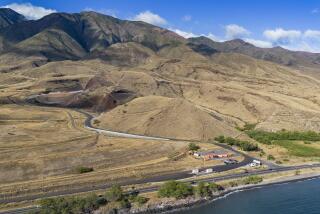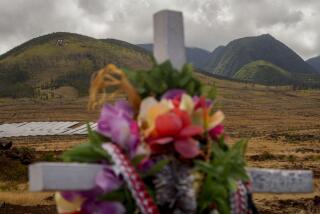Hawaii, Once Extinction Capital, Turns to Preservation : Environment: State accounts for nearly three-fourths of nation’s lost bird species. But a new breed of public official is coming to the rescue.
- Share via
KAUAI, Hawaii — Often called the extinction capital of the nation, Hawaii is becoming a preservation capital as well for endangered species.
In a state where rare birds and plant species have long been sacrificed to the gods of tourism and development, Hawaiians are becoming more aware than ever that irreplaceable wildlife and natural habitat may be lost forever.
“We’re trying to get out in front of the tide of extinction,” said Alan Holt, a biologist with the Nature Conservancy based in Honolulu.
This tide is moving rapidly. Of 69 bird species known to be native only to Hawaii, 24 have become extinct, giving the state the dubious distinction of accounting for nearly three-fourths of the nation’s extinct birds.
Hawaii also accounts for more than one-fourth of the nation’s endangered plant species, with half of its 2,400 plant species considered threatened.
The state’s treasured forest system, eighth largest in the United States although Hawaii has only two-tenths of 1% of the nation’s land area, is under pressure from wild pigs, goats and cattle that have uprooted or trampled native vegetation. “Our resources are under stress,” said William Paty, the state director of land and natural resources.
A new and deadly threat to birds may have appeared on supposedly snake-free Hawaii in the form of venomous brown tree snakes, which biologists fear may have arrived inadvertently by plane from the Solomon Islands by way of Guam after wiping out most of the birds there.
But Hawaiians are fighting back, demonstrating a consciousness that belies their reputation for environmental indifference.
The progressive Administration of Democratic Gov. John Waihee, the first native Hawaiian to serve as governor, has created a land bank in which the state has invested $40 million to preserve Hawaii’s most endangered areas.
The state also has formed a partnership with the Nature Conservancy to manage 18 natural resource communities that had been set aside on the six major Hawaiian islands--Hawaii, Kauai, Lanai, Maui, Molokai and Oahu.
Meanwhile, a new breed of local official, such as Democratic Mayor JoAnn Yukimura of Kauai, has won popular support with attempts to restrain the pell-mell development long prevalent here.
Yukimura, 41, a Stanford University graduate with a law degree from the University of Washington, returned to her home island to participate in an environmentalist movement that succeeded in establishing a four-story height limit on hotels and preserving such scenic treasures as the suspension bridge at Hanalei, gateway to the magical coastline on which “South Pacific” was filmed.
On her third try, Yukimura won a two-year mayoral term against a Republican supported by developers and then was reelected last year to a four-year term.
Even the business community shows increasing awareness that overdevelopment could ultimately menace tourism, which state economist Gregory Pai calls “the goose that lays the golden egg.”
The gold has been glittering less brightly at some luxury hotels on Kauai owned by U.S. and Japanese investors. Many have high vacancy rates, prompting some business executives to agree with Yukimura that “we don’t need more hotels.”
Jack Hoag, president of First Hawaiian Bank, observed that the most expensive resort hotels on Kauai have been developed at a cost of $500,000 a room, requiring a $500 nightly return to show a profit. “It is easy for the supply of such rooms to exceed the demand,” he said. “What we see is a case of Economics 101 taking over.”
But it is biology, not economics, that occupies conservationists trying to preserve the state’s unique and varied wildlife. Scientists here routinely observe that volcano-created Hawaii provides more varied examples of wildlife evolving into separate species than occur on the Galapagos Islands, where Charles Darwin made his famous studies of evolution.
A finch studied there by Darwin evolved into a dozen species. But a finch that reached the more isolated Hawaiian islands, with their myriad natural communities of differing altitudes, moisture and vegetation, evolved into 47 known species or subspecies.
These islands are rare biological laboratories where birds and plants have evolved in a nurturing environment. With no natural enemies here, birds and plants have proved easy prey to exotic species introduced from the mainland or from Asia. Only two animals, the hoary bat and monk seal, are native to Hawaii, and both are endangered.
Human beings have only recently begun to look on Hawaii as a natural laboratory. Since the Polynesians first colonized the islands in the early 5th Century, lowland forests were cleared to make way for agriculture, a process intensified in the late 18th Century, when European colonists began building sugar and pineapple plantations and establishing cattle ranches.
Most of the land below 1,500 feet was cleared, wiping out lowland species while leaving huge tracts of relatively unspoiled rain forests in the interior of the major islands.
It is largely the highland interior rain forests that the state and conservationist groups are struggling to preserve against heavy odds.
Holt observed that an island economy based on tourism finds it difficult to erect effective barriers against importation of alien wildlife and plant species.
On Maui and the Big Island, as the island of Hawaii usually is called, vast tracts of forests have been destroyed by feral pigs, goats, cattle and deer. The state has responded by hunting the animals and fencing off land. One species of sheep valued by hunters was destroyed because it was robbing nests of rare birds.
Paty noted that people also have brought destruction to protected lands, particularly on the Big Island. Marijuana growers were principal culprits, because they brought in wild seeds and weeds while tending and harvesting the outlawed drug.
The state, working with the Drug Enforcement Administration, killed off many of the marijuana plots with selective herbicides applied from helicopters. As a result, Paty said, Hawaii is “no longer the marijuana capital of the world.”
A worse nightmare for naturalists is the brown tree snake that may have secretly established itself on Kauai. These snakes made their way from the Solomons to Guam during World War II in Army cargoes. Lacking natural enemies, they destroyed the bird population on Guam. They now outnumber the residents there 150 to 1, cause power outages by swarming on transformers and are a danger to puppies, kittens and sometimes children.
Last October one such snake in the wheel well of a plane arriving from Guam slid onto the runway, where it was promptly killed. But there have been unconfirmed reports of brown-tree-snake sightings on Kauai, ironically the one Hawaiian island where snake-killing mongooses imported in the late 19th Century as an unsuccessful rat-control measure have not flourished.
“The brown tree snake had probably established itself on Guam for many years before we knew it was there,” Holt said. “But it quickly killed off the birds and would do the same in Kauai.”
There is no doubt about other menaces to wildlife. The beautiful and unique Hawaiian tree snail has been virtually extinguished by a cannibal snail brought in to control garden slugs. More than 70,000 acres of Hawaiian forests have been swallowed by the imported banana poka vine, which grows to the tops of trees and strangles them.
The last remaining o’o’, a lovely and once commonplace songbird whose name resembles its sound, apparently disappeared on Kauai last year. Ornithologists had recorded the sound of this bird and attracted what they thought was the last member of the species to a place in the forest. Last summer, the o’o’ never returned.
But naturalists also are counting unexpected victories, among them the doubling in numbers to about 20 of the alala, the rare Hawaiian crow that was thought to be near extinction. The endangered Molokai thrush also seems to be increasing in numbers.
Those struggling to save Hawaii’s endangered species acknowledge that they will not be successful in all cases. “We’re probably going to lose a few more species,” Holt said. “But if we stop, thousands more will be lost.”
More to Read
Sign up for Essential California
The most important California stories and recommendations in your inbox every morning.
You may occasionally receive promotional content from the Los Angeles Times.










